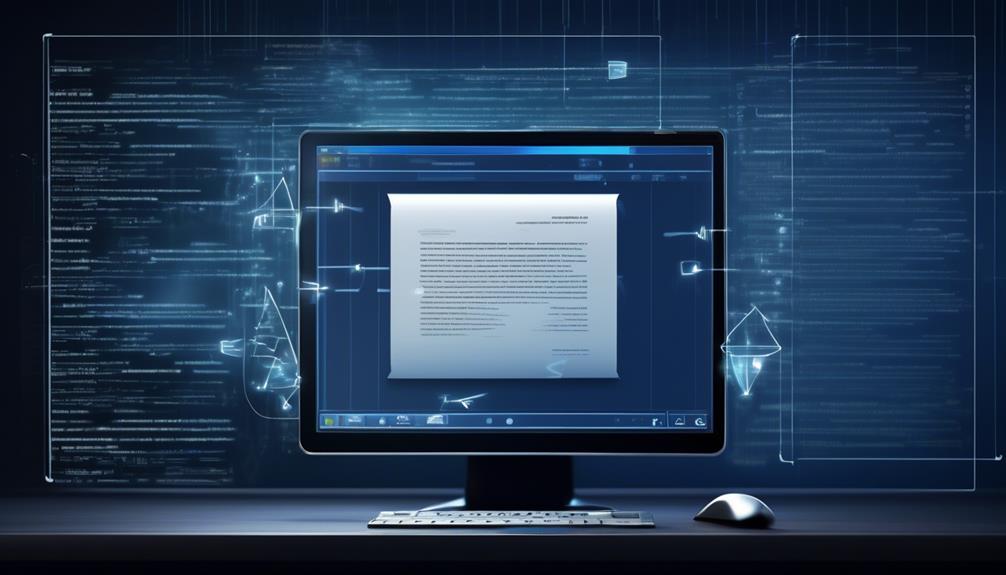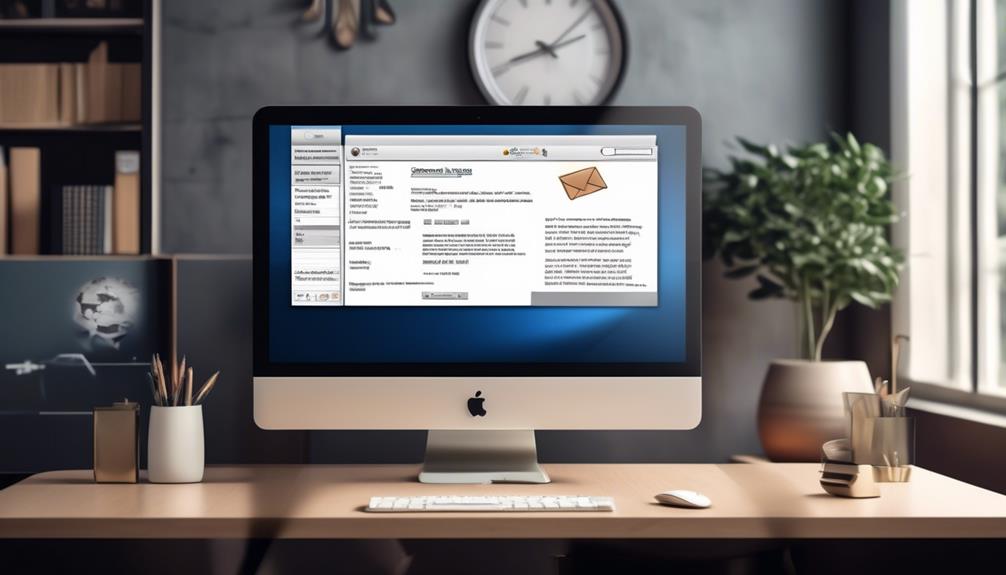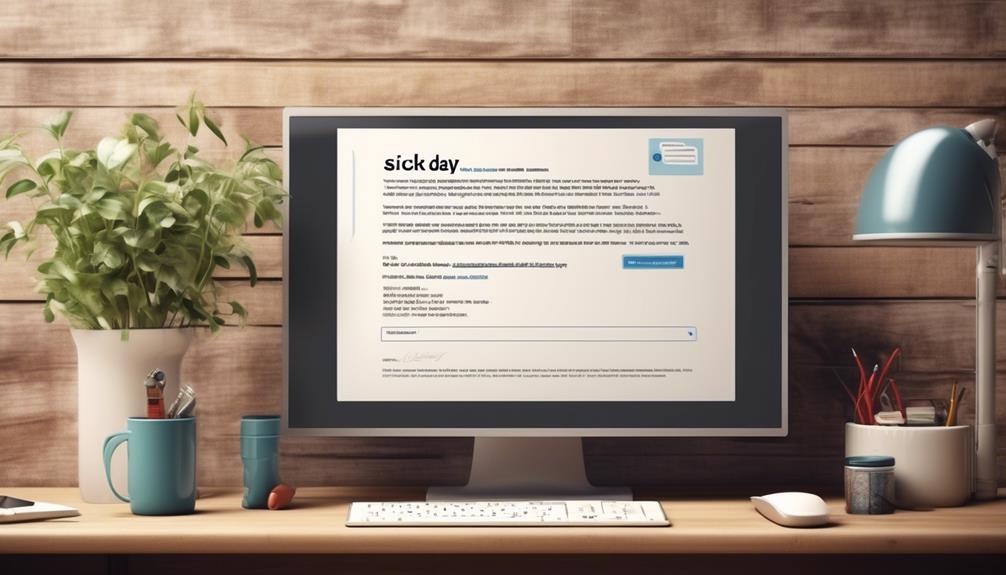Whenever we’re not feeling well, it’s important to write an email that is both easy to understand and thoughtful. Yet, it involves more than just mentioning we’ll be absent from the office.
How can we effectively communicate our absence, ensure that work doesn't fall through the cracks, and maintain professionalism? Let's explore some practical strategies for crafting a sick email that conveys the necessary information while maintaining a professional tone and ensuring that our absence doesn't disrupt workflow.
Key Takeaways
- Craft a clear and concise subject line that reflects the urgency and importance of the message.
- Clearly state the date of your return and your availability for urgent communication.
- Make arrangements for coverage of your tasks and meetings by identifying a colleague who can help cover your work.
- Clearly convey your condition and the expected duration of your absence.
Crafting a Clear Subject Line
We always make sure to craft a clear and concise subject line that effectively conveys the purpose of our email, ensuring it reflects the urgency and importance of the message. When writing a sick day email, the subject line plays a crucial role in communicating the situation to our colleagues or supervisors.
It's essential to include our name and the reason for our absence in the subject line. By crafting a clear subject line, we provide the recipient with immediate understanding, allowing them to prioritize and address the email promptly.
To maintain a professional and straightforward tone, we avoid using vague or ambiguous language in the subject line. Instead, we focus on clearly articulating the purpose of the email, which in this case is to inform about our sick leave.
This approach helps in setting the right expectations and ensures that the recipient comprehends the urgency of the situation. Our subject line reflects our commitment to clear and effective communication, ultimately facilitating a smooth and efficient response to our sick day email.
Setting Expectations for Your Absence

When setting expectations for our absence, it's crucial to clearly state the date of our return and our availability for urgent communication.
We should also communicate whether we'll be working from home and make arrangements for coverage of our tasks and meetings.
Identifying a colleague who can help cover our work and providing alternative contact information for emergencies are also important considerations.
Setting Return Date
Before planning your sick leave, it's essential to clearly indicate the date of your expected return in your email to set clear expectations for your absence. This will help your team and managers to make necessary arrangements and plan work accordingly.
When setting your return date, consider the following:
- Remote Work Availability: Communicate if you'll be available for remote work during your absence to manage expectations with your team.
- Urgent Tasks and Responsibilities: Communicate any urgent tasks or responsibilities that need to be reassigned or addressed in your absence.
- Point of Contact: Offer the name of a colleague who can cover your work or serve as a point of contact during your absence.
- Adherence to Company Policies: Ensure that your return date aligns with the company's sick leave policies and notify the human resources department as necessary.
Being clear about when you expect to be back and providing necessary contact information will ensure a smooth transition back to work.
Communicating Work Coverage
After setting your return date, it's crucial to communicate clear expectations for your absence by effectively outlining how your work will be covered in your email when communicating work coverage. Inform team members who'll be affected by your absence, ensuring they understand who to contact for urgent tasks. Clearly explain your ability to handle work remotely, if applicable, and specify which tasks need to be reassigned or rescheduled.
Be sure to adhere to the company's sick leave policies and designate a colleague who can help cover your responsibilities, providing their contact information. This will help ensure a smooth workflow in your absence and alleviate any concerns about task coverage.
It's important to set the right expectations and provide necessary support for the team to manage the workload effectively while you're out of the office tomorrow.
Communicating Your Condition
In our email, we need to clearly convey my condition and the expected duration of my absence. This is crucial for ensuring that our colleagues and supervisors understand the situation and can make appropriate arrangements.
When communicating your condition, it's important to be specific and transparent. Include details about the illness or circumstances that necessitate your absence, and provide an estimated timeline for your return to work. Be concise but thorough in your explanation to avoid leaving room for misinterpretation.
- Clearly state the nature of your illness or situation and how it impacts your ability to work.
- Specify the anticipated duration of your absence, including any potential remote work arrangements.
- Communicate any urgent or time-sensitive tasks that require immediate attention during your absence.
- Express your willingness to provide periodic updates on your condition and availability, as well as any changes to the expected duration of your leave.
Clarifying Work Responsibilities

To ensure a seamless transition during my absence, we will clearly outline and delegate specific work responsibilities to our colleagues. It's crucial to communicate with the team and manager to ensure that all tasks are covered efficiently. Below is a table outlining the tasks that need to be covered and the designated colleague responsible for each task.
| Task Description | Colleague Responsible |
|---|---|
| Client meetings | John |
| Project deadline | Sarah |
| Daily reports | Michael |
In the event of my absence, please contact the designated colleague for each specific task. I am unable to perform my duties as per the company's sick leave policies, and I appreciate your understanding and support during this time. Should you require any further assistance or information, please do not hesitate to reach out to me. Thank you for your understanding and cooperation in clarifying work responsibilities during my sick leave.
Notifying a Point of Contact

When notifying a point of contact about your sick leave, it's important to update them on your condition and expected duration of absence.
Additionally, you should mention whether you'll be working from home during your sick leave and provide any information about rescheduled or reassigned tasks.
It's crucial to ensure that your point of contact is aware of any colleague who can help cover your work in your absence.
Contact Notification Process
Upon receiving a sick leave request, it's essential to promptly notify the designated point of contact with the necessary details for continuity of work responsibilities. When contacting the designated point of contact, ensure to use a professional and concise tone.
Here's how to effectively notify the point of contact:
- Send a Detailed Email: Use sick day email templates to clearly state your condition, the expected duration of your absence, and whether you'll be working from home.
- Make Sure to Include Work Details: Specify any work that needs to be rescheduled or reassigned and designate a colleague who can help cover your responsibilities.
- Let Them Know about Out-of-Office Responses: Set up an automatic out-of-office response for emails and voicemails, and provide alternative contact information for emergencies.
- Please Contact Your Colleague: End the email professionally by providing contact information for the colleague designated to cover your work.
Point of Contact Update
We promptly notify the designated point of contact with the necessary details for continuity of work responsibilities upon receiving a sick leave request. It is crucial to provide comprehensive information to ensure a smooth transition during your absence. Here's a helpful table to guide you on the essential details to include in the email notification:
| Information to Include | Example |
|---|---|
| Reason for absence | Flu symptoms |
| Expected duration of absence | 3 days |
| Working from home during sick leave | Yes |
| Important work to be reassigned | Client meeting on Thursday |
Notifying Contact Person
As part of our commitment to seamless communication and effective handover processes, we ensure to promptly inform the designated point of contact of any upcoming absence due to illness, detailing all pertinent information for continued workflow.
- Take a sick day and clearly state the condition and expected duration of absence.
- Specify if you'll be working from home during your sick leave.
- Communicate any work that needs to be rescheduled or reassigned to your colleagues.
- Provide the name of a colleague who can help cover your work in your absence.
Addressing Remote Work Possibilities

Exploring the possibility of working remotely due to illness is a crucial consideration for maintaining productivity and managing responsibilities. When addressing remote work possibilities in a sick email, it's essential to clearly communicate the details of your absence and your intention to work from home, if applicable. This ensures that your colleagues and supervisors are informed and can plan accordingly. Additionally, it's important to specify any tasks that need to be reassigned or rescheduled and provide the name of a colleague who can assist in covering your responsibilities. Here's a helpful table to include in your email to effectively convey this information:
| Remote Work Possibilities | |
|---|---|
| Mention condition and expected duration of absence | Specify intention to work from home during sick leave |
| Communicate any work that needs to be reassigned or rescheduled | Provide the name of a colleague who can help cover responsibilities |
Requesting Assistance If Needed

Hey team, when requesting assistance while being sick, it's important to do so politely and be specific about the help needed.
Clearly outlining what support is required and how colleagues can help can ensure a smoother transition during your absence.
Remember to communicate any specific tasks or responsibilities that need to be covered to help avoid any disruptions in workflow.
Requesting Help Politely
Reaching out for assistance in a courteous manner is important when writing a sick email, as it demonstrates respect for the recipient's time and consideration. When requesting help politely, I make sure to:
- Start the email with a polite greeting and express appreciation for the recipient's time and understanding.
- Clearly state the reason for seeking assistance and provide specific details about the help needed.
- Express understanding of the recipient's potential constraints and assure them that any assistance, even if partial, would be greatly appreciated.
- Offer to reciprocate the favor in the future, if possible, and express gratitude in advance for any assistance provided.
Being Specific About Needs
When seeking assistance in the event of illness, it's crucial to clearly communicate the specific needs and expectations for your absence to ensure a smooth transition for your colleagues.
In the sick day email, be specific about the reason for your absence and the anticipated duration of your leave. If you plan to work from home, explicitly state this in the email. Clearly outline any tasks that need to be rescheduled or reassigned, providing specific details to help your colleagues understand the situation.
Additionally, if you have a doctor's note, mention it in the email. Identify a colleague who can assist in covering your workload while you're absent and include their name in the email.
Outlining Your Return Plan

Upon my return, I plan to provide a comprehensive update on the status of my projects and discuss any necessary adjustments to our workflow. Here's how I plan to make a smooth transition back into work:
- Status Update: I'll communicate the progress and any setbacks on the projects I was working on before my sick leave. This will ensure that everyone is up to speed and can make informed decisions about next steps.
- Workflow Adjustments: I'll analyze the impact of my absence on our workflow and propose any necessary adjustments to ensure that we stay on track with our goals.
- Reassigned Work: If any work was reassigned during my absence, I'll follow up with the colleagues who took on those tasks to ensure that everything was completed satisfactorily.
- Coverage Plan: I'll designate a colleague who can help cover my workload in case I need additional support upon my return. This will help minimize any inconvenience caused by my absence.
I understand that my sick day may have caused some inconvenience, and I appreciate your understanding and support during this time. I'm committed to ensuring a smooth return and appreciate your cooperation as we work through this transition.
Adhering to Company Policies

To ensure compliance with company policies, it's essential to clearly communicate the reason for your absence and the expected duration in your sick day email. When crafting the email, make sure to adhere to the specific guidelines outlined in the company policies regarding sick day notifications.
It's important to let your supervisor and any relevant team members know about your absence as soon as possible, ideally at the start of the workday today. Additionally, ensure that you provide an alternative contact person who can handle any urgent work matters during your absence, in line with company procedures.
While it's crucial to be informative about your absence, it's equally important to respect the privacy of your health information. By following company policies when composing your sick day email, you not only demonstrate professionalism but also contribute to a smooth workflow despite your absence.
This approach helps to ensure that your team is well-informed and that work can continue without major disruptions.
Providing Contact Information

In my email, I'll clearly state my name and position in the company, while also providing a contact number and email address for urgent communication. This ensures that anyone needing to reach me can do so easily.
Additionally, I'll include alternative contact information for my manager or supervisor, who'll be able to manage my workload in my absence. It's important to mention the expected duration of my absence and any arrangements for working from home, if applicable.
By doing so, I can ensure that my absence doesn't disrupt the workflow and that any urgent matters are appropriately addressed.
When providing my contact information, I'll use a professional and courteous tone in the email to convey my commitment to fulfilling my responsibilities despite being away. This will also reassure my colleagues that I'm approachable and available for any necessary communication.
Handling Mental Health Days

As a team, we recognize the importance of acknowledging the need for mental health days in our communications. When requesting a mental health day, it's crucial to communicate openly and honestly.
In your email, clearly state that you need to take a sick day for mental health reasons. Be transparent about your expected absence and any potential impact on urgent matters or deadlines.
Offer suggestions for covering your workload in your absence, demonstrating your commitment to ensuring that essential tasks are still completed. Express your willingness to assist in any way possible to ensure a smooth day in your absence.
It's essential to keep the email professional and respectful while maintaining privacy about your mental health. Remember, the goal is to rest and recover, so be sure to communicate your needs effectively while also considering the impact on your team.
Offering Well-Wishes

We genuinely care about your well-being and are here to offer any support you may need during your absence. It's important to prioritize your health, so please take the time you need to fully recover.
Here are a few ways we can support you during this time:
- Workload Assistance: We can help redistribute your workload and ensure that your responsibilities are taken care of while you're away.
- Flexible Schedule: If you need to ease back into work gradually, we can discuss a flexible schedule upon your return.
- Emotional Support: Whether it's a friendly chat or professional guidance, we're here to provide emotional support during this period.
- Stay Connected: Even while you're away, we hope to keep you in the loop so you can jump back in seamlessly when you're feeling better.
We understand the importance of taking the time to rest and recover, and we want to encourage you to stay home and prioritize your well-being. We hope this email finds you on the mend, and please let me know if there's anything specific we can do to support you.
Sending you our warmest well-wishes for a speedy recovery.
Sample Sick Day Email Template

With the goal of effectively communicating your absence and ensuring a smooth transition of responsibilities, here is a sample template for a sick day email.
Subject: Sick Day – [Your Name]
Dear [Supervisor's Name],
I am writing to inform you that I'm unwell and will need to take a sick day off from work on [date]. I anticipate being able to return to work on [expected return date], pending a swift recovery. Due to my condition, I'll not be able to work from home during this time.
As a result, I kindly request your assistance in reallocating my pending tasks and appointments to ensure that they're adequately covered in my absence. I've notified [colleague's name] about my situation, and they've agreed to stand in for me during this period. You may reach out to them for any urgent matters that require immediate attention.
I will set up an automatic email response to notify correspondents of my absence and provide alternative contacts for urgent matters. I apologize for any inconvenience this may cause and appreciate your understanding.
Thank you for your attention to this matter.
Sincerely,
[Your Name]
Can the Same Format be Used for Writing a Sick Email and a Correction Email?
Yes, the same format can be used for writing a sick email and a correction email. Both types of emails should start with a clear subject line and a polite greeting. Be direct and specific about the reason for writing the email, and offer a solution or alternative plans. Accuracy and empathy are key in writing an email correction.
Frequently Asked Questions
How Do You Write a Simple Sick Email?
We write a simple sick email by clearly stating our condition and expected duration of absence.
We provide information on whether we'll be working from home and any tasks that need to be rescheduled or reassigned.
We assign a colleague who can help cover our work and set up an automatic out-of-office response for emails and voicemails.
Timing is important, so we ensure our email is professional and detailed while maintaining privacy.
How Do You Say I Am Sick Professionally?
We inform others about our illness professionally by clearly stating our condition and expected absence duration.
We specify if we'll work from home and address any rescheduled or reassigned work.
We provide a backup colleague and follow communication protocols.
Setting up an automatic out-of-office response and including alternative contact info is crucial.
It's essential to keep the email professional, brief, and to the point while including all necessary information.
How Do You Politely Email Sick Leave?
We politely email sick leave by clearly stating our condition and expected duration of absence, offering to work from home if possible, and mentioning any work that needs to be rescheduled or reassigned.
We assign a colleague to cover our work and set up an automatic out-of-office response for emails and voicemails.
Keeping the email detail-free to maintain privacy, we provide alternative contact information for emergencies and offer assistance in ensuring a smooth day in our absence.
How Do You Write a Sick Out of Office Email?
We write a sick out-of-office email by clearly stating our condition and expected absence duration. We mention if we'll work from home, any rescheduled work, and provide a colleague's contact.
An automatic out-of-office response with our return date is set up. The email is professional, brief, and includes alternative contact info for emergencies.
This ensures a smooth transition during our absence.
Conclusion
In conclusion, when writing a sick email, it's important to communicate clearly, set expectations, and provide necessary information.
Just like a well-oiled machine, a well-crafted sick email ensures that work continues smoothly in your absence.
Take care of yourself and don't hesitate to reach out if you need any assistance.










